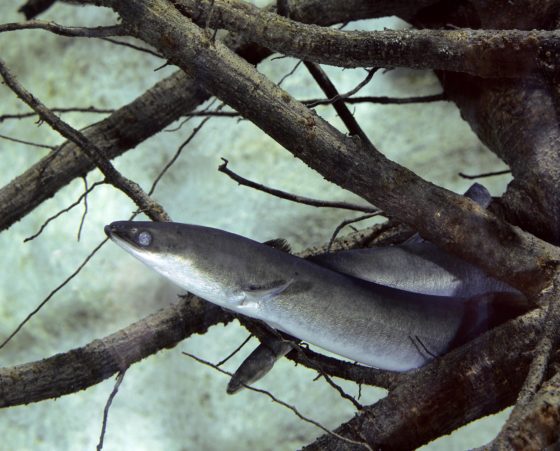
This week, the recurring Swedish television programme Uppdrag Granskning – Mission: Investigate in English – highlighted the plight of the European eel and the ineffectiveness of many of the current management measures. It focused particularly on the devastating effects of hydropower installations and the costly, artificial support provided by restocking and trap-and-transport.
In the one hour show called The last eel, a team of investigate Swedish journalists provided the Swedish public with unique insight about the mysterious and fascinating life of the European ell, and the many threats to the survival of this ancient species.
With effective graphics, they showed how at least Sweden has now supplemented its natural life cycle with a ”modern” man-made life cycle, beginning with Leptocephalus larvae arriving naturally to the Severn river in the United Kingdom, where the glass eels are caught and translocated by air to a quarantine facility in Helsingborg, Sweden, driven by pick-up to the Swedish west coast and selected lakes and rivers. After around 20-25 years of living and growing in the Swedish freshwater systems, it is fished up again, driven by lorry past the hydropower stations to the Baltic and west coast. This is now the life cycle of 9/10 of eel in Swedish freshwater, they tell us.
The programme also looks more closely at restocking and the fact that many restocked eels do not seem to be able to find their way back to the Sargasso Sea, even after they are released at the coast. They point out that the International Council for Exploration of the Sea (ICES) advises that restocking should not be used as an alternative to reducing anthropogenic mortality, and that the external evaluation of the EU eel management system (Regulation 1100/2007) concluded that restocking is “a short to medium term measure that is unsustainable and should be phased out”. According to Andrew Kerr from the Sustainable Eel Group, who is interviewed, restocking is “masking the cause and effect. You do your restocking and you think you are solving the problem, but you are not.”
Another main point made in the programme is the immense difference between how eel deaths caused by fishing and eel deaths caused by hydropower is managed. According to Uppdrag Granskning, there is no consistent monitoring of eels killed in hydropower turbines in Sweden, and restocking continues to take place above hydropower dams, resulting in many unnecessary deaths. The remaining eel fishers on the other hand, are strictly regulated and controlled.
They home in on the hydropower companies. Despite a decade of a special measures programme called Krafttag ål – Powergrab eel – agreed between the Swedish Agency for Marine and Water Management (SWAM) and Sweden’s largest hydropower producers, few long-term solutions to support the eel have been implemented. Instead, efforts have been focused on restocking, followed by trap-and-transport. And recently, even these efforts have been reduced, with the power companies referring to lower expected profits and general cuts in spending.
In the programme, we also meet the author of the acclaimed The Gospel of the eels – Patrik Svensson – and a team of artists and musicians currently creating an opera performance based on the book. They talk about how the eels, with their mysterious ways that we do not yet fully understand, leads us to contemplate the wider wonders of the world and look beyond the relationship of an animal to man.
It is particularly painful to watch a young eel slowly scaling the wall of a hydropower dam. After hours of climbing up the vertical surface, it succumbs when it reaches the dry top of the barrier. At the end of the programme, one of the biologists participating asks himself – will we be the last generation to see eels in our waters, or the generation that saved them?
Most of the programme is in Swedish, but there are some sections filmed in the UK and the graphics are self-explanatory, so it may be worth a watch even if you are not a native speaker. It is available for viewing outside of Sweden on SVT Play: https://www.svtplay.se/video/32908367/uppdrag-granskning/uppdrag-granskning-den-sista-alen